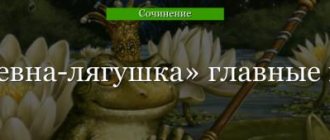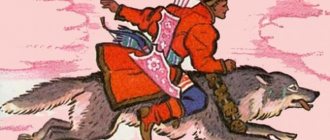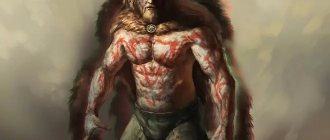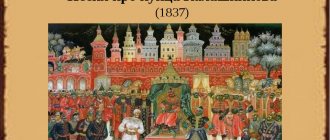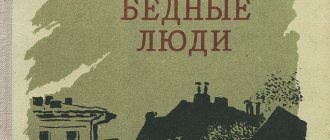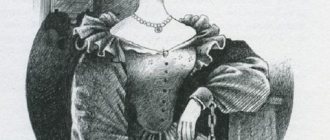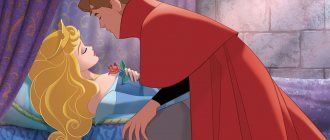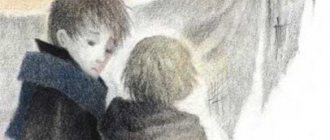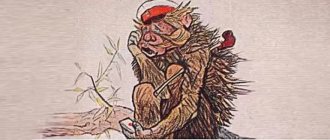Plot description
The king decided that the time had come for his three sons to get married and ordered them to shoot their bows at random in different directions. Where the arrow fell, therefore, young people should look for their fate there.
The arrows of the two eldest sons flew to the merchant and boyar yards. They married the daughters of a merchant and a boyar. And the youngest son Ivan’s arrow flew into the swamp. When he found it, he saw that the frog was holding the arrow in its paws and did not want to give it up. In a human voice, she demanded that Ivan marry her, as his father commanded. Not daring to disobey his father, the young man had to take her as his wife.
However, it was not enough for the Tsar to simply marry his sons; he decided to test their wives. The old father ordered his daughters-in-law to do 3 tasks for him:
- sew a shirt;
- bake bread;
- come to the royal feast.
Ivan became sad, realizing that the frog was unlikely to be able to cope with his father’s tasks. But she was able to sew a shirt and bake bread, and much better than the brothers’ wives. Ivan did not see how she did this, because everything happened at night while he was sleeping.
Night transformation
The young man did not know that his frog princess’s name was Vasilisa the Wise. She grew up and became smarter than her father, so she was turned into a frog for 3 years. For a short time, Vasilisa could shed her skin and take on her true appearance, so with the help of nannies she successfully completed two of the king’s tasks.
To come to the feast, she had to reveal herself to everyone. The wives of her older brothers began to envy her beauty and skill. They tried to imitate Vasilisa in everything, but only angered the king.
While his wife was having fun at the feast, Ivan ran home and burned the skin of the frog. He thought that in this way Vasilisa would remain in human form forever. But it turned out that he only had to wait 3 days for the curse to fall from the girl, and now Vasilisa had to return to Koshchei the Immortal.
Search for a wife
Ivan Tsarevich had no choice but to go look for his wife. He wandered around the world for a long time until he met an old man who gave him a magic ball that showed him the way. While the young man was following the ball, he came across various animals and birds on his way:
- bear;
- hare;
- drake;
- pike.
Ivan wanted to hunt them, but the animals asked in a human voice not to kill them, promising to be useful to him someday. The young man took pity on them and let them go.
Finally, the ball led the prince to Baba Yaga's hut. After the young man rested, took a steam bath and had dinner, the old woman told him how to kill Koshchei. It turned out that the death of the enemy is in the egg, which lies in the chest. The chest itself is suspended on the branches of a huge oak tree, so it is impossible to get it. But Ivan still decided to try, and Baba Yaga showed the way to the oak tree.
The tree really turned out to be huge, but then a rescued bear appeared from somewhere and uprooted it. The chest fell and opened, a hare jumped out of it and ran away. However, another hare quickly caught up with him - the one whom Ivan took pity on and did not kill. A duck flew out of the hare, but the drake caught it. An egg fell out of the duck and straight into the sea. But the pike managed to grab him and hand him over to Ivan. The young man took a needle from the egg and broke it. Koschey died, and Vasilisa became free.
Analysis of a fairy tale
Plot
During the course of the story, the tsar arranges three tests for his daughters-in-law, two of which the older daughters-in-law successfully failed, and the wife of Ivan Tsarevich, who turned out to be actually the enchanted girl Vasilisa the Beautiful, coped with them perfectly, bringing the tsar into admiration. On the third task, she had to appear at a feast thrown in honor of the king's daughters-in-law in her human form, completely charming the king.
Taking advantage of the opportunity, the frog's young husband goes home, finds the frog's skin and burns it in the oven. As a result of this rash act, he loses his wife, who goes to the kingdom of Kashchei the Immortal. All that remains for Ivan Tsarevich is to follow her in order to return her. Along the way, he meets various fabulous animals who are ready to help him for the lives and help he saved. Among his supporters is the fabulous Baba Yaga, whom Ivan conquered with his good manners. She also told him about an effective way to destroy Kashchei. As a result of long adventures and the help of animal friends, Ivan defeats Kashchei and returns Vasilisa the Beautiful.
Fairy tale characters
There are quite a few characters in the fairy tale. Despite the fact that the role of each individually is not significant, all together they are important for the overall development of the plot. Heroes of the fairy tale “The Frog Princess”:
- Ivan is the youngest son of the Tsar.
- The Frog Princess is an enchanted girl named Vasilisa, nicknamed the Wise One for her intelligence.
- The Tsar is the father of Ivan and his brothers.
- The brothers' wives are envious people.
- The old man is a casual acquaintance who gave the prince a magic ball.
- Baba Yaga is a forest dweller who showed the way to the magic oak tree and told how to kill Koshchei.
- The bear helped to fell the oak tree.
- Hare - was able to catch up with another hare from the chest.
- Drake - killed a duck that flew out of a hare.
- Pike found an egg that had fallen into the sea.
All the characters in the fairy tale “The Frog Princess” are simple and understandable. You can easily determine which of them are positive and which are not. That is why the fairy tale is included in the 5th grade school curriculum. Children of this age can already distinguish good from evil, good from bad.
Presentation on literature “Russian folk tale “The Frog Princess”. Composition of a fairy tale" (5th grade)
art therapy specialist
Description of the presentation by individual slides:
Meeting with a fairy tale... Meeting with a fairy tale is a joy for every person, especially for a child. You are already experienced readers of fairy tales and know quite a lot of them. What Russian folk tales do you remember? What attracts us to fairy tales? Of course, miracles, transformations, magical fairy-tale objects and fairy-tale characters. What magical objects are found in Russian folk tales? What fairy tale characters are active?
Composition (structure) of a Russian folk tale. Magic fairy tale "The Frog Princess".
Russian folk tales.
What is a fairy tale? A fairy tale is the great spiritual culture of a people, which we collect bit by bit, and through a fairy tale the thousand-year history of the people is revealed to us. (Alexey Nikolaevich Tolstoy) The fairy tale is a lie, but there is a hint in it! A lesson to good fellows. (A.S. Pushkin)
A fairy tale is an entertaining story about extraordinary fantastic fictional events and adventures. Types of fairy tales, fairy tales about animals, magical, everyday
Fairy tales about animals have a special meaning, because animals and birds are very similar to people, therefore they help us understand human characters and relationships between people. Let's remember the characters of fairy-tale characters. What are the types of hare, fox and bear? Give examples of fairy tales. Everyday tales are completely different. They are closely related to real life, so they are very similar to true stories. Fiction merges with reality. Very often in such fairy tales such qualities as greed, cowardice, deceit, and greed are ridiculed.
Fairy tales captivate our imagination. Baba Yaga, Koschey the Immortal, and the Serpent Gorynych confront heroes who protect their loved ones, fight evil forces and are sure to defeat them.
A bit of repetition. What kind of fairy tales are these? Determine their type.
LANGUAGE OF FAIRY TALES Language means: constant epithets (p. 297), hyperboles (p. 292).
Physical exercise. Choose a movement - do the exercise.
The king's first order
Expressive reading of a fairy tale episode (p. 18 “Suddenly...”)
Reproduction of the painting by V.M. Vasnetsov “Kashchei the Immortal”
Let's work on the structure of the fairy tale "The Frog Princess"
The composition of the fairy tale “The Frog Princess” The saying The joke is at the very beginning of the fairy tale The beginning The beginning of the fairy tale. Talks about the location of the action, about the characters who will be in the fairy tale. Fabulous events Main events. The protagonist or heroine fights an opposing force and always defeats it or solves difficult riddles Ending Happy ending. The last words of a fairy tale
The composition of a fairy tale The saying The joke is at the very beginning of the fairy tale “In a certain kingdom, in a certain state...” Beginning The beginning of a fairy tale. Talks about the location of the action, about the characters who will be in the fairy tale. The king ordered his sons to get married. The youngest is Ivan Tsarevich. Fabulous events Main events. The main character or heroine fights an opposing force and always defeats it or solves difficult riddles. Prince Ivan meets a frog. Wisdom of Vasilisa. Ivan goes in search of his wife and meets a bear, a hare, a duck, a drake, a pike. Ivan Tsarevich kills Koshchei and returns to the palace with Vasilisa the Beautiful. Ending Happy ending. The last words of the fairy tale “And they began to live and live, to plow the field, to sow rye and wheat. This is where the fairy tale ends.”
This is the end of the fairy tale... The main characters and the plot of the fairy tale itself introduce us to folk moral precepts. And the thoughts that permeate the text teach not to judge a person only by appearance, but to evaluate him by his deeds and inner merits.
Homework Read the fairy tale “Ivan the Peasant Son and the Miracle Yudo” (pp. 28-38), retelling. Individual task: draw an illustration for the fairy tale “The Frog Princess”, write oral comments on the drawings.
Material number: DB-681364
Didn't find what you were looking for?
You might be interested in these courses:
Characteristics of the main characters
There are quite a lot of heroes in a fairy tale, which is why it is important for students to be able to distinguish the main characters from the secondary ones. This is not difficult to do; you just need to determine around whom the entire plot of the work revolves, and who only randomly appears and disappears in the story. There are only 3 main characters in The Frog Princess:
- Ivan Tsarevich.
- Vasilisa the Wise (frog)
- Tsar.
The characteristics of the main characters are important for presenting the overall picture of the plot. Each of these heroes played a certain role so that the fairy tale was exactly the way readers are accustomed to perceive it. After all, if you exclude any of these characters from the work, the plot of the story will immediately become incomprehensible and uninteresting.
Ivan Tsarevich
There is no clear description of the hero's appearance in the text of the fairy tale. But we can assume that he was a stately young man, not devoid of intelligence and courage. This image emerges from the reader’s mind from Ivan’s actions and actions. For example, he was not afraid to go on a long journey in search of his wife.
Kindness is a distinctive character trait of a young man. This is evidenced by his good deeds towards the animals he meets. It can be assumed that during the young man’s travels, hunting was his only source of food. Despite the fact that he himself could remain hungry, the prince takes pity on the animals and does not kill them.
Obedience and respect for elders characterize Ivan on the positive side. He did not dare to disobey his father and took a frog as his wife, although he understood that everyone would make fun of him. He also behaved politely when visiting Baba Yaga, although he could have simply intimidated the old lady. This behavior greatly helped Ivan, because Baba Yaga might not have told the secret about the death of Koshchei the Immortal.
Of course, Ivan Tsarevich can be called a positive hero. Even the only bad deed - burning the skin of a frog - he committed out of ignorance and with good intentions.
Vasilisa the Wise
The image of the Frog Princess in the fairy tale is spelled out in two ways. On the one hand, she’s just an ordinary swamp resident, on the other, she’s a beautiful girl. Vasilisa does not immediately admit to Ivan that she is not just a frog. This speaks about the intelligence of the main character, because she could not know what the young man would turn out to be like. The following traits can be traced in the character's character:
- Kindness - she takes pity on her beloved husband when he is sad.
- Modesty - the girl does not give in to provocations and does not react to the ridicule of her older brothers’ wives.
- Trick - Vasilisa deceives the woman sent to watch her when she tries to spy on how the frog bakes bread.
At first glance, Vasilisa the Wise is a positive character. She didn't do anything bad to anyone. But if you take a closer look, she also had few good deeds: even the king’s tasks were carried out by her mothers and nannies for her. It was because of her carelessness and distrust of her beloved husband that Ivan had to overcome so many difficulties to save her. So it’s a stretch to call this heroine a positive character, although it’s also impossible to call her a negative one.
Tsar, father of three sons
A wise ruler, a loving father - this is how this main character can be described. His wisdom is manifested in actions. Having decided to marry his sons, he did not choose brides for them himself, just as he did not want to rely on the choice of the children themselves. He correctly reasoned that if there were girls somewhere destined for them as wives, fate itself would bring their sons to their doorstep. The king decided to use an arrow as the finger of this very fate.
Love for his sons can also be traced in the further actions of the Tsar. He understood that it was not entirely correct to hope for one fate. The elderly father wanted to see his grandchildren and also make sure that his children would have a happy marriage. And this, as you know, largely depends on the woman as the keeper of the home.
It is not enough to have a noble origin; a young wife must also be a good housewife. So the Tsar decided to check what kind of housewives his young daughters-in-law were by inventing tests for them.
A sense of justice is also not alien to this character. He understands that the wives of his eldest sons are not such good girls as they want to seem, so he drives them away from the feast.
The king in the fairy tale is clearly a positive hero, because all his actions are aimed only at the benefit of his sons.
A very brief summary for a reader's diary
By order of the king, his sons had to get married. He ordered them to choose brides in this way: to shoot with a bow in an open field. Where the arrow fell, there everyone had to look for a bride.
The youngest son, Ivan Tsarevich, found his arrow in a swamp. He had to marry a frog.
The frog coped with the king’s tasks better than the wives of his eldest sons. She came to the feast in the guise of a beauty.
Ivan Tsarevich burned the frog's skin so that his wife would always remain beautiful. But because of this, his wife disappeared. The prince found her at Koshchei the Immortal, defeated this villain and freed his wife.
Brief Analysis
To better understand the theme and meaning, you should understand what this fairy tale represents and teaches. If you analyze the work in dry literary language, its analysis will look like this:
- The title is “The Frog Princess.”
- The year of writing is unknown.
- The author is the people.
- Genre: folk tale.
- The main characters are Vasilisa the Wise, Ivan Tsarevich, and the Tsar.
- The theme is the search for Vasilisa.
- The main idea is to do good and it will come back to you.
The fairy tale teaches children kindness and mutual assistance. Helps you understand that any good deed is not done for someone else, but first of all for yourself. There is no need to demand gratitude from others; good people themselves will not forget to reward if necessary. You need to live according to your conscience, with kindness in your heart and with intelligence in your head.
